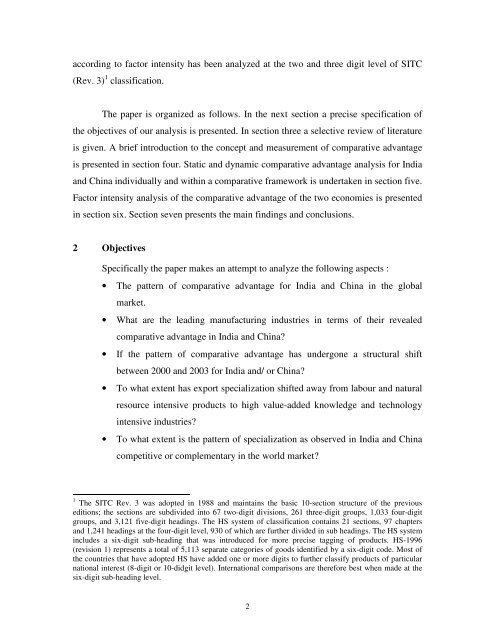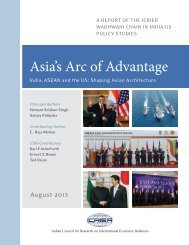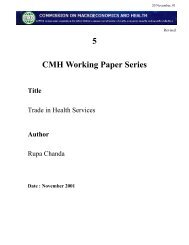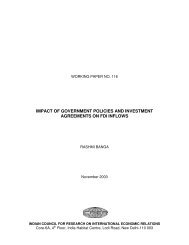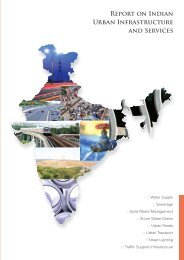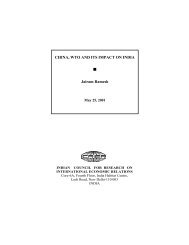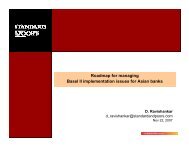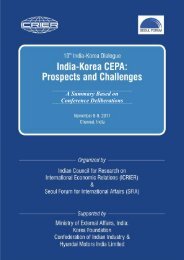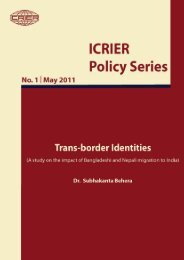an analysis for india and china - icrier
an analysis for india and china - icrier
an analysis for india and china - icrier
Create successful ePaper yourself
Turn your PDF publications into a flip-book with our unique Google optimized e-Paper software.
according to factor intensity has been <strong>an</strong>alyzed at the two <strong>an</strong>d three digit level of SITC<br />
(Rev. 3) 1 classification.<br />
The paper is org<strong>an</strong>ized as follows. In the next section a precise specification of<br />
the objectives of our <strong>an</strong>alysis is presented. In section three a selective review of literature<br />
is given. A brief introduction to the concept <strong>an</strong>d measurement of comparative adv<strong>an</strong>tage<br />
is presented in section four. Static <strong>an</strong>d dynamic comparative adv<strong>an</strong>tage <strong>an</strong>alysis <strong>for</strong> India<br />
<strong>an</strong>d China individually <strong>an</strong>d within a comparative framework is undertaken in section five.<br />
Factor intensity <strong>an</strong>alysis of the comparative adv<strong>an</strong>tage of the two economies is presented<br />
in section six. Section seven presents the main findings <strong>an</strong>d conclusions.<br />
2 Objectives<br />
Specifically the paper makes <strong>an</strong> attempt to <strong>an</strong>alyze the following aspects :<br />
• The pattern of comparative adv<strong>an</strong>tage <strong>for</strong> India <strong>an</strong>d China in the global<br />
market.<br />
• What are the leading m<strong>an</strong>ufacturing industries in terms of their revealed<br />
comparative adv<strong>an</strong>tage in India <strong>an</strong>d China?<br />
• If the pattern of comparative adv<strong>an</strong>tage has undergone a structural shift<br />
between 2000 <strong>an</strong>d 2003 <strong>for</strong> India <strong>an</strong>d/ or China?<br />
• To what extent has export specialization shifted away from labour <strong>an</strong>d natural<br />
resource intensive products to high value-added knowledge <strong>an</strong>d technology<br />
intensive industries?<br />
• To what extent is the pattern of specialization as observed in India <strong>an</strong>d China<br />
competitive or complementary in the world market?<br />
1 The SITC Rev. 3 was adopted in 1988 <strong>an</strong>d maintains the basic 10-section structure of the previous<br />
editions; the sections are subdivided into 67 two-digit divisions, 261 three-digit groups, 1,033 four-digit<br />
groups, <strong>an</strong>d 3,121 five-digit headings. The HS system of classification contains 21 sections, 97 chapters<br />
<strong>an</strong>d 1,241 headings at the four-digit level, 930 of which are further divided in sub headings. The HS system<br />
includes a six-digit sub-heading that was introduced <strong>for</strong> more precise tagging of products. HS-1996<br />
(revision 1) represents a total of 5,113 separate categories of goods identified by a six-digit code. Most of<br />
the countries that have adopted HS have added one or more digits to further classify products of particular<br />
national interest (8-digit or 10-didgit level). International comparisons are there<strong>for</strong>e best when made at the<br />
six-digit sub-heading level.<br />
2


